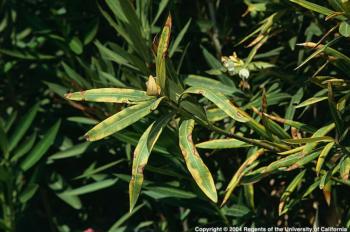DISEASE FOCUS: Scorch diseases caused by Xylella fastidiosa
by Jim Downer
For many years plant pathologists and horticulturists have struggled with scorch diseases. Specific strains of the bacterium Xylella fastidiosa caused disease in various hosts. For instance the almond leaf scorch strain causes disease in almond while the Pierce’s disease strain causes disease in grape. Unfortunately the host range of a given strain is not unique to its host and can be quite large depending on the strain. Until several years ago strain-host specificity was kept narrow by a limited number of sharpshooter insect vectors with narrow host ranges. When the glassy-winged sharpshooter (GWSS) was introduced to California, it changed everything because this insect has a wide host range, can acquire numerous strains of X. fastidiosa and spread them to hosts that have never before experienced these strains. To make matters more complex, some strains may reside in one host without causing disease but when moved to a susceptible host may be pathogenic. As a result, the ornamental tree industry has been widely affected in both nurseries (Huang 2007) and landscapes (Hernandez-Martinez et al. 2009) with new disease showing in olive, sweet gum, oleander (fig. 1), purple leaf plum, gingko, mulberry, silk trees and jacaranda. Scorch may also be occurring in other ornamental trees that have not yet been diagnosed as hosts.

Xylella fastidiosa is a fastidious mollicute, that is, a gram negative bacterium that must inhabit the xylem of a living host in order to reproduce. The bacterium causes disease when it multiplies and clogs xylem vessels in sapwood. This reduces the water supply to foliage which then wilts or yellows leaves and defoliates branches and ultimately kills its host. The symptoms somewhat mimic Verticilium wilt but without the staining of the xylem that is observed in that disease. Symptom development is quite variable depending on the strain found in the host. Krugner et al. (2014) suggest that in olive, infections may be self-limiting, and that chronic infection may not be common. It was certainly difficult for Krugner and others to infect and redetect the bacterium in healthy olive plants. I have also observed landscape olives with symptoms of infection that recovered. Krugner et al. further suggest that olive is often infected by canker-forming fungi that could account for scorch symptoms and so suggest that X. fastidiosa may not be the cause of symptoms seen in landscape olives. This logic may also be applied to other Xylella hosts such as Liquidambar (sweet gum) which are similarly affected by numerous fungal pathogens such as Botryosphaeria. However, Hernandez-Matinez et al. (2009) verify that the strain of Xylella causing disease in sweet gum can reproduce disease in healthy trees, thus suggesting it is the likely source of scorch symptoms in X. fastidiosa positive trees. These two examples underpin the need for continued careful research on each strain and host interaction in order to understand these diseases.
Jim Downer is Environmental Horticulture Farm Advisor, UC Cooperative Extension, Ventura County.
References
Hernandez-Martinez R, Cooksey DA, Wong, FP. 2009. Leaf scorch of purple-leafed plum and sweetgum dieback: Two new diseases in Southern California caused by Xylella fastidiosa strains with different host ranges. Plant Dis. 93:1131-1138.
Huang Q. 2007. Natural occurrence of Xylella fastidiosa in a commercial nursery in Maryland. Can. J. of Plant Path. 29:299-303.
Krugner R, Sisterson, MS, Chen J, Stenger, DC, Johnson, M W. 2014. Evaluation of olive as a host of Xylella fastidiosa and associated sharpshooter vectors. Plant Dis. 98:1186-1193.












